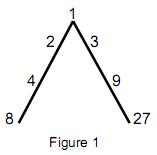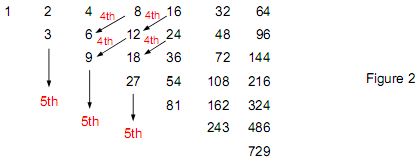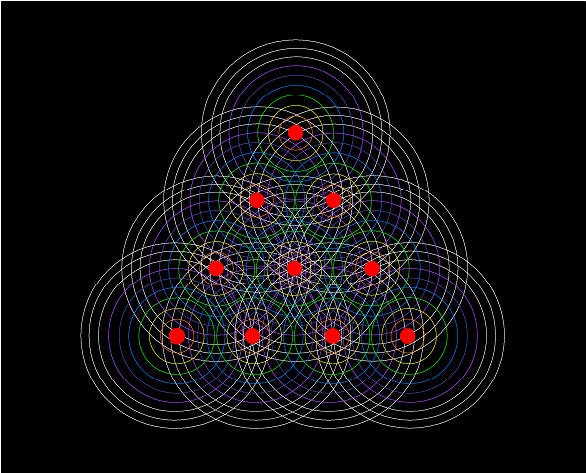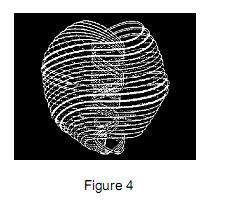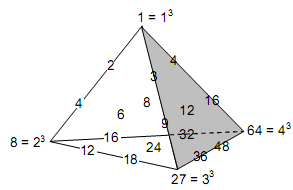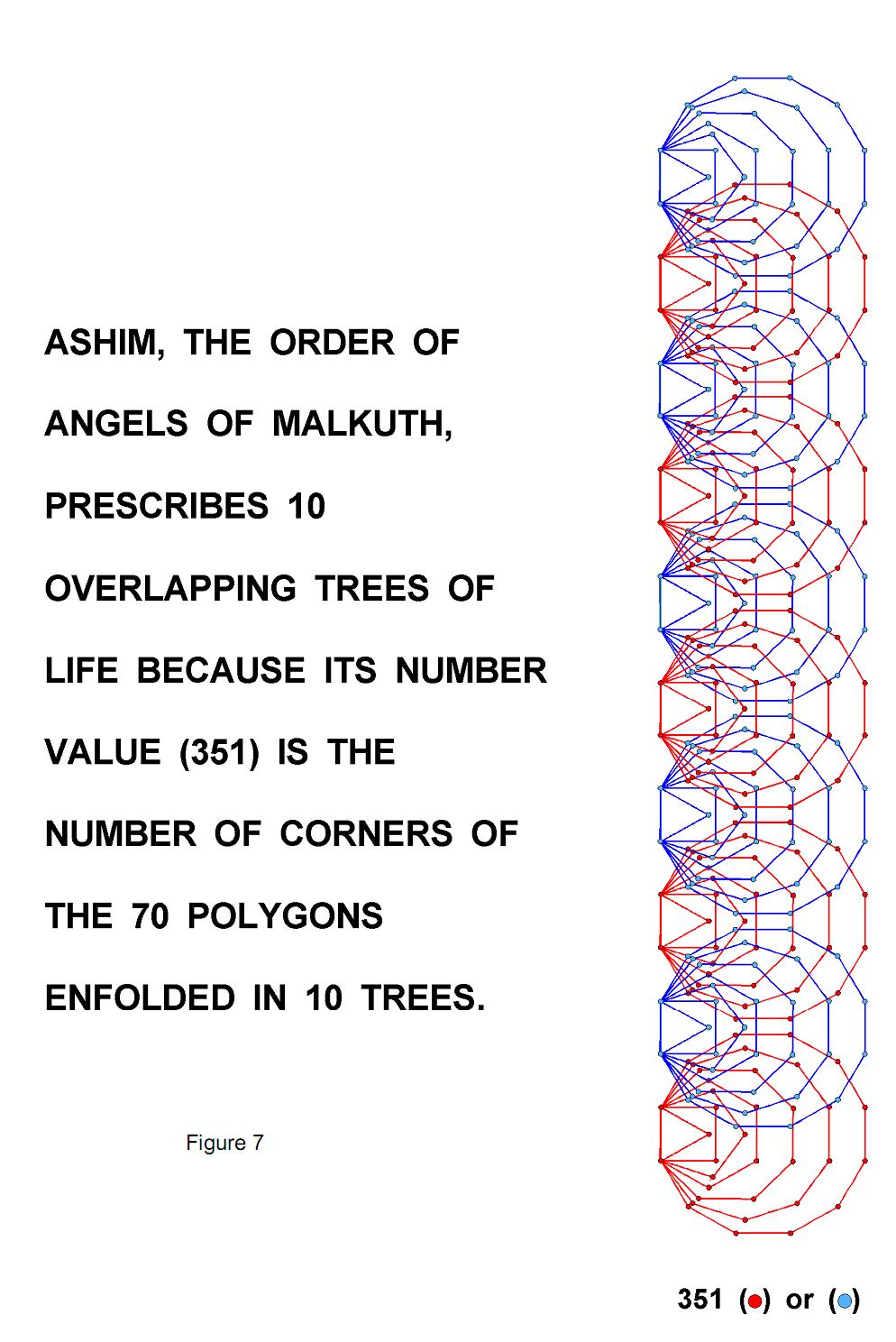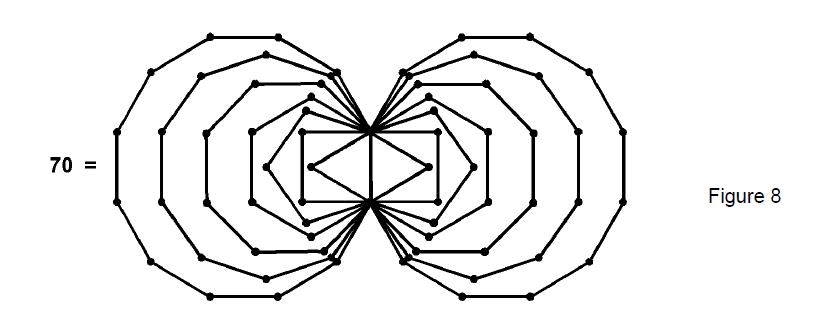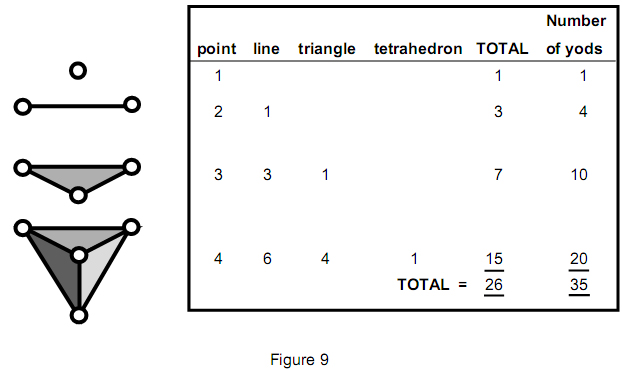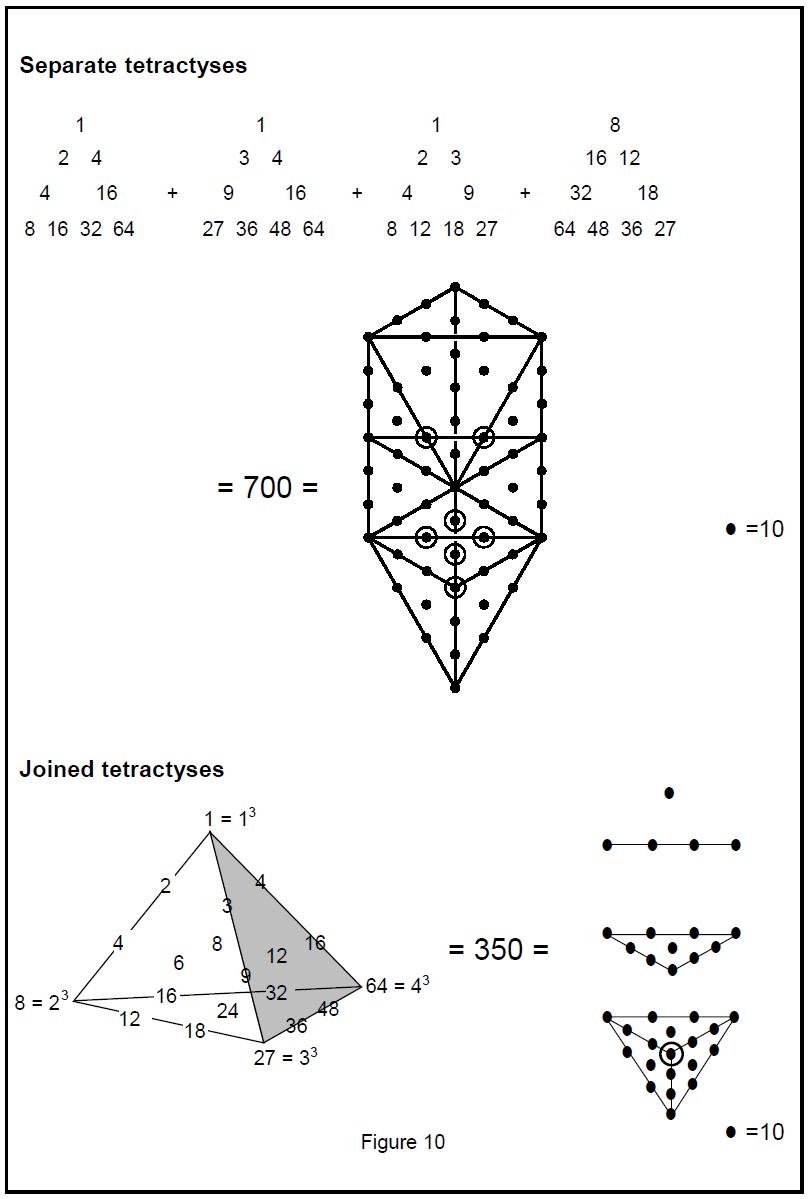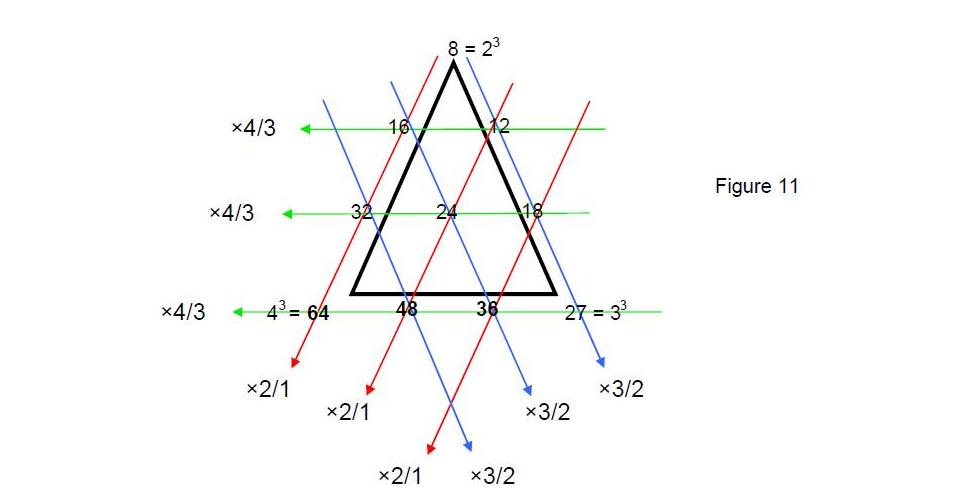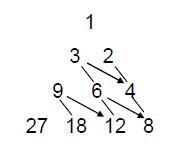|
ARTICLE 11
by Stephen M. Phillips Flat 4, Oakwood House, 117-119 West Hill Road. Bournemouth. Dorset BH2 5PH. England. Website: http://smphillips.mysite.com
Abstract
1.
Introduction 1 Locri
(possibly a real person), describes how the Demiurge divided the World Soul into harmonic
intervals. Having blended the three The horizontal rows of integers in Figure 2 are geometric progressions by 2 and the rows descending diagonally are geometric progressions by 3. Consecutive vertical numbers are to each other in the ratio 3/2, defining the perfect fifth, whilst consecutive, diagonally paired numbers (shown by arrows) are in the ratio 4/3, defining the musical fourth. The *H is the harmonic mean of two positive numbers a and b (b›a) if (b-H)/(H-a) = b/a. A is their arithmetic mean if (b-A)/(A-a) = 1. 2 tetractys of integers at the beginning of the Table of Lambda:
(it will be called the "Lambda Tetractys") serves as the basis of musical harmony. Using the octave of 6:12, their arithmetic mean is 9, which, in relation to 6, is in the ratio 3:2. This is the perfect fifth. The harmonic mean of 6 and 12 is 8. This proportion, 8:6 or 4:3 is the perfect fourth. But 12:9 is also 4:3, that is, a perfect fourth, whilst 12:8 is also 3:2, which is a perfect fifth. The ratio 9:8 defines a whole tone. The central integer 6, which is absent from the series of integers: 1, 2, 3, 4, 8, 9, 27 in the Lambda, is pivotal to discussion of the mathematical proportions of the notes belonging to the musical octave for the following reason. If the integer n is chosen as the fundamental frequency, then the first overtone, or octave, has a frequency of 2n. The harmonic mean of these integers is (4/3)n, which is the perfect fourth. The arithmetic mean of n and 2n is 3n/2; this is the perfect fifth. The smallest value of n defining integer values of both the perfect fourth and fifth is 6. In general, because n has to be divisible by both 2 and 3, that is, by 6, both means are integers if n = 6N, where N = 1, 2, 3, etc. Because of the pivotal importance of the number 6 at the centre of the above tetractys, one can speculate that Plato concealed his knowledge of and indebtedness to Pythagorean teachings by revealing in his book Timaeus only seven of its ten integers. This is certainly possible, for the mathematical secrets of the Pythagoreans were in Plato’s time still part of their arcane spiritual philosophy, closely guarded by generations of Pythagoras’ followers until they were written down for the first time by Philolaus of Tarentum, whose book, Fragments, Plato obtained from Philolaus’ parents (2). The modern scientific mind, accustomed to being able to read the latest published research in a field of study, cannot understand the need for such secrecy because it does not recognise the existence of a spiritual knowledge that transcends ordinary knowledge. 2. Another meaning of the Lambda
Tetractys 3
Figure 3. The 90 circles symbolise the 90 Trees of Life above the lowest one (denoted by the tetractys) and the sum (90) of the ten integers in Plato’s Lambda tetractys. 4 This unfolding is not in linear time and so the stages of the manifestation represented by the ten points of the tetractys must be considered as simultaneous. The ten Sephiroth of the Tree of Life, which these points symbolise, denote co-existing modes of being, not processes occurring sequentially in time, which characterises only the last Sephirah, Malkuth, the physical universe. All objective Creation manifests as the Divine Qualities of the seven Sephiroth of Construction. They are denoted by the seven points within the three corners of the tetractys symbolising the Supernal Triad, or triple Godhead. Imagine a series of nine circles converging towards each point of a tetractys (Fig. 3). Each circle symbolises a Sephirothic hue in the ‘spectrum of consciousness.’ The outermost, three white circles formally correspond to Kether, Chokmah and Binah and the six coloured circles represent the Sephiroth of Construction above Malkuth, which is denoted by the red dot at the centre of each set of concentric circles. The material manifestation in time of the cosmic blueprint of the tetractys (the ten, red dots) requires (10×9=90) circles. God becomes immanent in space-time only by ‘stepping down’ — so to speak — His consciousness ninety times. Each circle corresponds to a Tree of Life, so that the Divine consciousness has 91 levels (3), the 91st (represented by the tetractys of ten red dots) completing God’s immanence in physical matter — or, rather, as matter. The sum of the ten numbers of Plato’s complete Lambda Tetractys:
is 90, which numbers the gradations of consciousness beyond the most physical level of consciousness, as symbolised by the 90 circles in Figure 3. Each circle signifies a Tree of Life, and the emanation of successive Trees generates six, so-called ‘Sephirothic levels’ because the number of such levels in n overlapping Trees of Life is given by S(n) = 6n + 4, so that S(n+1) – S(n) = 6(n+1) + 4 – (6n + 4) = 6, i.e., there are six such levels between similar Sephiroth of adjacent Trees, every seventh Sephirah being of the same kind. The emanation of the 90 Trees represented by the 90 circles therefore generates (90×6=540) Sephirothic levels. The last of these levels is the
5 commencement
(Kether) of the lowest Tree. 540 is the sum of the numbers generated by multiplying
each number in Plato’s Lambda Tetractys by its central integer 6:
This is the real reason why the Timaeus of Plato describes the numbers of the Lambda as being the ‘numbers of the World Soul.’ Superphysical reality in its broadest sense is the 540 Sephirothic levels spanning the Cosmic Tree of Life (CTOL) down to the top of the lowest (91st) tree, which represents the most ‘Malkuth,’ or physical, level of CTOL. The central number 6 in the Lambda Tetractys corresponds to the six coloured circles centred on the red dot at the centre of the tetractys of red dots shown in Figure 3. These circles denote the six trees of the 7-tree above the lowest tree in CTOL, which is symbolised by this tetractys of red dots. The position of the number 6 at the centre of the Lambda Tetractys is appropriate because the 7-tree corresponds to Malkuth, mapping in Theosophical terms the seven subplanes of the physical plane. The sum of the nine integers surrounding the centre of the Lambda Tetractys is 84, which is the number of trees in CTOL above the 7-tree. This denotes the 84 subplanes beyond the physical plane belonging to the six superphysical planes and to the six cosmic superphysical planes. The number 36 at the centre of the tetractys shown above is the number of Sephirothic levels in seven Trees of Life, counting from the top of their lowest tree. The sum of the six numbers at the corners of the hexagon in this tetractys:
is the number of Sephirothic levels in 49 overlapping Trees of Life down to the top of their lowest one. The sum 504 of the nine integers of this tetractys surrounding the central integer 36 is the number of Sephirothic levels in CTOL down to the top of the seventh tree, whilst the sum 540 of all ten integers is the number of levels in CTOL down to the top of the lowest tree. Amazingly, the three numbers 36, 288 and 540 measure the number of emanations of, respectively, seven, 49 and 91 Trees of Life — all analogous manifestations of the seven Sephiroth of Construction (see Article 5). The corresponding numbers for the original tetractys forming Plato’s Lambda are 6, 48 and 90 — the number 6 of trees above the lowest tree in, respectively, seven, 49 and 90 trees. We see now why Plato spoke of its numbers being the ‘numbers of the World Soul.’ They signify more than the meaning of the mathematical harmony of the tones of the musical scale, which the World Soul was supposed to embody. Numbers of the Lambda tetractys refer to realms of consciousness beyond the physical universe mapped by the 7-tree, or physical plane, this being to the 49-tree, or ‘cosmic physical plane,’ what the latter is to CTOL itself. 3. Superstring connection
4. Generalisation of the Lambda as
tetractys 7 others generates two new Lambda Tetractyses:
The three tetractys arrays can be regarded as forming three faces of a tetrahedron with the number 1 at a corner, the face opposite it being formed by their bases:
As successive integers on the left slope of the new Lambda are twice the previous one, the missing central integer not shared with the other Lambdas is 2×12 = 24 =1×2×3×4. The generalisation of the Platonic Lambda creates a tetrahedral array of 20 integers (4): Figure 5. The tetrahedral generalisation of the Platonic Lambda. Their sum is 350. This number is the sum of the four integers 1 = 13 , 8 = 23 , 27 = 33 and 64 = 43 at the apices of the tetrahedron: 13 + 23 + 33 + 43 = 100, and the 16 (=42) integers at positions of yods corresponding to Sephiroth of Construction, which sum to 250. The sum of the four integers 6, 8, 12 and 24 at the centres of the tetractyses (these correspond to Malkuth) is 50, which is the number value of the Godname Elohim assigned to Binah. This means that the sum of the 12 integers on the six edges of the tetrahedron that are not at corners is (250–50=200). The sum of all 16 8 integers on its boundary is therefore (100+200=300). Notice that the proportions of these sums for integers on the edges of the tetrahedron are 100:200:300 = 1:2:3. The four central integers 24, 12, 8 and 6 define, respectively, in terms of the fundamental tone 6, the frequencies 4/1 = 4, 4/2 = 2, 4/3 = 4/3 and 4/4 = 1. They are thus determined by the integers 1, 2, 3 and 4, which are symbolised by the four rows of the tetractys. The 20 integers are arranged in four layers containing 1, 3, 6 & 10 integers. The sum of the ten integers in the highest three layers of the tetrahedron shown in Figure 5 is 65, which is the number value of Adonai, the Godname of Malkuth. The three of these at the centres of tetractyses sum to 26, which is the number value of Yahweh, the Godname of Chokmah, whilst the sum of all four integers at centres of tetractyses is 50, the number value of the Godname Elohim assigned to Binah, the next Sephirah after Chokmah. 5. Tree of Life
significance of the number 350 350 = 250 + 100 between the sum of the integers at the apices of the tetrahedral array of integers and the remaining 16 integers has a remarkable counterpart in the inner form of the Tree of Life (Fig. 6). Its seven regular polygons have 36 corners, ten of which belong to the last polygon, the dodecagon. This means that the 7n regular polygons enfolded in n overlapping Trees of Life have (35n+1) corners, where ‘1’ denotes the uppermost corner of the hexagon enfolded in the nth tree. The latter coincides with the lowest corner of the hexagon enfolded in the (n+1)th tree. The 7n polygons therefore have 35n corners that are unshared. Enfolded on each side of the central pillar of ten overlapping Trees of Life 9 10 are 70 polygons (Fig. 7) with (35×10=350) such corners, of which (10×10=100) belong to the dodecagon, the tenth of the regular polygons. We see that generalisation of the Platonic Lambda Tetractys leads to a tetrahedral array of 20 integers that sum to the number of unshared corners of the 70 polygons enfolded in ten overlapping Trees of Life. This number of trees is highly significant because of its centrality to the comparable spiritual maps of the 10-fold Tree of Life and Pythagorean tetractys, and the various ways whereby the superstring structural parameters 1680 and 16800 recorded by Besant and Leadbeater are encoded in ten Trees of Life have been discussed in previous articles. Moreover, the sum of the 36 integers on the edges of the four separate tetractyses is 700, which is the number of corners of ten separate sets of (7+7) polygons constituting the inner form of the Tree of Life because each set has 70 corners (Fig. 8), a set of seven polygons having 36 corners, where 36 is the number value of Eloha, the Godname of Geburah. In view of the fact that the separate and the adjoined tetractyses sum to the numbers of corners in either ten separate sets of (7+7) polygons or in ten enfolded sets of seven polygons, it seems implausible to dismiss both these remarkable properties as coincidence. The presence of Godname numbers, such as 26, 50, 36 and 65, which characterise properties of the tetrahedron of integers with the mathematical proportions of the musical scale, further demonstrates that the pattern displayed in Figure 5 is truly archetypal. The Godname Yahweh with number value 26 prescribes the number 351: 1 + 2 + 3 + 4 + … + 26 = 351, as the 26th triangular number. It is the total number of corners of the 70 polygons enfolded in ten, overlapping Trees of Life. 350 is, therefore, the sum of the 25 integers after 1. These integers have the following remarkable arithmetic connection with the 11 number 248, the number of gauge bosons predicted by superstring theory to transmit the unified, E8-symmetric force between superstrings of ordinary matter:
In other words, 248 is the arithmetic mean of the squares of the 25 integers after 1. For any positive integer n, n2 is the sum of the first n odd integers. The number of odd integers summing to these 25 squares is therefore 2 + 3 + 4 + … + 26 = 350, which is the sum of the 20 integers in the tetrahedral array of generalised Lambda Tetractyses. 350 is prescribed also by the Godname Elohim in the following way. As 35 = 62 – 1 = 3 + 5 + 7 + 9 + 11, i.e., 35 is the sum of the first five odd integers after 1, 350 (=10×35) is the sum of (10×5=50) odd integers, where 50 is the number value of Elohim, the Godname of Binah. The number 350 has a unique connection to the ‘trunk’ of the Tree of Life, comprising the point, line, triangle and tetrahedron (Fig. 9): Its 26 geometrical elements are prescribed by Yahweh, whose number value is 26. When the five triangles of the trunk are turned into tetractyses, with its ten lines each made up of four yods, it comprises 35 yods. They are 12 13 made up of the ten Sephirothic points and 25 other yods. If the number 10 is assigned to each of its 35 yods, the trunk embodies the number 350, the Sephirothic points generating the number 100 (Fig. 10). This division: 350 = 250 + 100 was found earlier for the tetrahedral array of integers. The four integers 13, 23, 33 & 43 at the apices creating the shape of the tetrahedron and summing to 100 correspond to the ten Sephirothic points with the number 10 assigned to them that mark out the basic shape of the Tree of Life. The 16 other integers summing to 250 correspond to the 25 other yods in its trunk with the number 10 assigned to them. The division: 350 = 50 + 100 + 200, found earlier for the four integers at centres of tetractyses summing to 50, the four integers at the apices that sum to 100 and the 12 other integers on the edges of the tetrahedron summing to 200, has its correspondence in the trunk of the Tree of Life:
Notice that corresponding yods in the tetrahedron and trunk are of the same type, i.e., 1. both integers at centres of tetractyses and the numbers 10 at centres of tetractyses in the trunk sum to 50, 2. corners of Lambda Tetractyses summing to 100 correspond to Sephirothic corners of triangles adding to 100, and 3. integers at positions of hexagonal yods on sides of tetractyses that sum to 200 correspond to hexagonal yods on lines with the number 10 assigned to them. These correspondences demonstrate that the tetrahedron of four Lambda Tetractyses is the counterpart of the trunk of the Tree of Life. The 40 integers in the four separate tetractyses sum to 750. This is 15×50, where 15 is the number of Yah, one of the two Godnames assigned to Chokmah, and 50 is the number of Elohim, the Godname assigned to Binah. Figure 10 indicates that the 36 integers on the sides of the tetractyses prescribed by the Godname Eloha of the Sephirah Geburah with number value 36 sum to 700 — the same as the number generated by assigning the number 10 to the 70 yods of the Tree of Life with its 16 triangles turned into tetractyses. In this sense the boundaries of the four separate Lambda Tetractyses are the arithmetic counterpart of the complete Tree of Life, whilst the corresponding edges of the 14 tetrahedron whose 16 integers sum to 300 are the counterpart of the 30 yods with 10 assigned to them that delineate the geometrical outline of the trunk of the Tree of Life (this formally includes the yod symbolising the mathematical starting point). The sum of the 16 integers at the corners and centres of the four separate tetractyses is 350 — the same as the sum of the 20 integers in the tetrahedron whose faces the tetractyses form. As the fourth triangular number, the tetractys is the fourth stage of differentiation of the Pythagorean Monad:
A tetrahedron whose faces are tetractyses symbolises this differentiation in 3-dimensional space because it consists of four layers, each being a triangular number corresponding to one of these stages. The sums of the integers in successive layers of the Lambda tetrahedron shown in Figure 10 are listed above. ‘1’ denotes the mathematical point, the Monad ‘10’ (the sum of the four integers in the highest two layers) signifies its 10-fold differentiation into the 10 yods of the tetractys or the 10 Sephiroth of the Tree of Life. ‘65’(the sum of the 10 integers in the highest three layers) signifies the
10-fold differentiation of the Tree of Life into the 10-tree, which has 65 SLs. The sum (350) of all 20 integers in the tetrahedron is the number of corners intrinsic to the 70 polygons enfolded in the 10-tree and representing its inner form. The tetrahedral generalisation of the Platonic Lambda therefore signifies in geometric terms the four stages of differentiation of Divine Unity (Monad) into the perfect number 10 (tetractys) expressing the 10-fold nature of God, whilst it expresses arithmetically the four stages: Kether* → Tree of Life → 10-tree (outer form) → 10-tree (inner form) culminating in the inner form of the 10 lowest Trees of Life in CTOL. As was shown in
*One of the Kabbalistic titles of Kether is “The Primordial Point.” 15 earlier articles, these encode the group-theoretical forces and the oscillatory structure of superstrings. The sum of the 10 integers in Plato’s Lambda Tetractys is 90 and the sum of the 10 integers in the tetrahedron outside this face is (350–90=260). This is the number of yods in the seven enfolded polygons outside their shared root edge. Just as these polygons 'grow' out of the root edge, so three tetractys faces are generated in succession from the Lambda Tetractys, which is the counterpart of the root edge. Once again, the mathematical archetype embodied in the Godname Yahweh prescribes an archetypal form defining the mathematics of both the Pythagorean musical scale and
superstrings — the former pertaining to vibrations in air and the latter to vibrations in the fifth Element or Hindu tattva, namely, space, or Akasha, as it known in Indian cosmology. 6. The ‘perfect’ Lambda
Tetractys
2/1 is the frequency of the octave, 3/2 is the frequency of the perfect fifth (arithmetic mean of 2 and 1)) and 4/3 is the frequency of the perfect fourth (harmonic mean of 1 and 2). The complete tetractys version of Plato’s Lambda: 16
generates these ratios because adjacent pairs in the same row are always in the same ratio 3/2 and corresponding pairs in adjacent rows linked by the diagonal arrows are in the same ratio 4/3, whilst integers linked by diagonal lines are in the ratio 2/1. Adjacent members of the same row in the two new Lambda Tetractyses are in the ratios 2/1 and 4/3. This means that the base of the tetrahedron formed by the three Lambda Tetractyses exhibits all three ratios 4/3, 3/2 and 2/1 in the horizontally and diagonally linked pairs (shown in Figure 11 by the green, red and blue arrows). Only in this fourth tetractys, which is opposite the apex of the tetrahedron with 13 assigned to it (see Figure 5 or 10), do all three ratios simultaneously pertain between pairs of integers that are naturally adjacent to each other in the sense that they lie on lines parallel to the sides of the tetractys. In the case of the original Lambda Tetractys, such pairs of integers exhibit only the ratios 2/1 and 3/2, the pairs that define the ratio 4/3 being linked by arrows that are not parallel to any side of the tetractys. The fourth tetractys can be said therefore to be the perfect version of Plato’s Lambda Tetractys because only in the former is the pairing of integers with the proportions of 2/1, 3/2 or 4/3 always parallel to a side of the tetractys. Quite apart from their summing to the number of corners of the 70 polygons enfolded in ten overlapping Trees of Life, with those at the vertices summing to the number of corners of the ten dodecagons outside the edges they share with other polygons, the tetrahedral array of integers has the additional merit of generating a Lambda Tetractys of integers whose natural, nearest neighbour pairings exhibit all three tonal ratios. It is unlikely, therefore, to be coincidental that the ten integers above this base of the tetrahedron sum to 65. This is because 65 is the number value of the Godname Adonai assigned to Malkuth, the Sephirah at the base of the Tree of Life, being the number of Sephirothic levels in the lowest ten trees of CTOL symbolised in Figure 3 by the tetractys of red dots (the lowest tree) and the nine circles centred on the central dot. The relevance of this section of CTOL to the universe of superstrings is simply that these ten trees bear a correspondence to the ten lowest tree levels of CTOL that denote the ten dimensions of space-time in which matter takes the form of superstrings (see Article 2). Furthermore, it 17 is appropriate that the number at the apex of this tetractys determining the tonal ratios of the eight notes of the musical scale should be 8! At the centre of the fourth tetractys is the note with a musical proportion of 24 (notice that 24 = 1×2×3×4). It has a frequency of 4 relative to the fundamental tone with a musical proportion of 6 and frequency of 1. It is the fourth harmonic, the tone of a vibrating string shortened to one-quarter of the length that generates the fundamental tone. This harmonic completes two whole octaves spanning 15 notes, where 15 is the number value of Yah, the older form of the Divine Name assigned to Chokmah. This is also the number of corners, edges, triangles and tetrahedra in the tetrahedron (see Figure 9). As 15 = 24 – 1, it is the fourth Mersenne number.* This is how the Pythagorean Tetrad (4) determines not only the four-cornered tetrahedron, whose generation from the Platonic Lambda creates the tone ratios of the notes of the diatonic scale, but also its geometrical composition. As the final multiplier of the Pythagorean Monad generating the 20 integers that form the four tetractys faces of the tetrahedron, the number 4 represents the stage of completion of the unfolding of the 10-fold unity of the Monad symbolised by the tetractys. It finalises the mathematical pattern of harmony between the musical tones and defines the dimensionality of both superstrings and the 15-dimensional space from which they are created (see Article 2). No wonder, then, that the Pythagoreans gave to it the title “holding the key of nature.” 7.
Conclusion *The nth Mersenne number is: Mn = 2n – 1. 18 was merely a means to an end — a way of purifying the soul in preparation for contemplating the Absolute on its own transcendental level. For the Pythagoreans, however, study of their sacred mathematics led the soul into an awareness of God in the here and now. It was, ironically, the former view of mathematics as purely a vehicle for expressing a higher, spiritual dialectic (Platonic idealism) that influenced the development of pure mathematics divorced from spiritual principles and — more important still — the emergence of ‘natural philosophy’ and then modern science without any motivation deeper than that of accumulating knowledge and understanding and of making life more comfortable. For many people, the fact that the Lambda Tetractys generates the tone ratios of music will be merely a mathematical curiosity without even fundamental significance, let alone, spiritual meaning. This is because their denial of the reality of a spiritual, or archetypal, basis for logical thought (what the ancient Greeks called ‘dianoia’) and their rejection of what they regard as a magical way of thinking in terms of correspondence and analogy makes them unable to recognise as such universal patterns that link the particulars. For anyone who is a Pythagorean, the connection between music, the Lambda Tetractys and its tetrahedral generalisation has a more profound significance. It demonstrates the universal applicability of the tetractys as a representation of the ten-fold nature of Divinity. For this mathematical symbol transcends cultural paradigms and man-made theologies. It expresses the 10-fold nature of Divine Immanence in the phenomenal world, as particle physicists have unconsciously revealed in their discovery that the space-time of superstrings needs to be ten-dimensional. Just as mathematics is the language of the Divine Mind in which, as Galileo said, the book of Nature is written, so music is the natural language of the soul. Its mathematical composition must therefore reflect the similar, perfect harmony of the soul. References 1. Theories of the Universe, edited by Milton K. Munitz (The Free Press, New York, 1957), p. 75. 2. The Pythagorean Sourcebook and Library, Kenneth Sylvan Guthrie (Phanes Press, 1987), p.167. 3. ‘Levels of consciousness’ are not synonymous with ‘states of consciousness.’ There are a finite, discrete number (91) of the former but an unlimited number of the latter as variations of the continuum of consciousness defined within each of these primary modalities, of which there are seven. 19
4. Occult Chemistry, 3rd ed., Annie Besant and C.W. Leadbeater (Theosophical Publishing House, Adyar, Chennai, India, 1951). 5. Particle physics provides the following counterpart to the tetrahedral generalisation of the Lambda: when the fourth, so-called ‘charmed’ quark is added to the up, down and strange quarks, the tetractys arrangement of ten, spin-3/2 bound states of three quarks of these types, which belonged to the original “Eight-fold Way” scheme for classifying strongly interacting, subatomic particles, becomes the base of a tetrahedral array of 20 such baryons with each of its faces a tetractys array of particles. Is this not an example of the “Tetrad Principle” formulated in Article 1, whereby the fourth member of a class of mathematical object (in this case, the tetrahedron — the fourth in the geometric sequence: point, line, triangle, tetrahedron) embodies numbers (in this case, 20) of fundamental significance to the study of nature? 20 |

